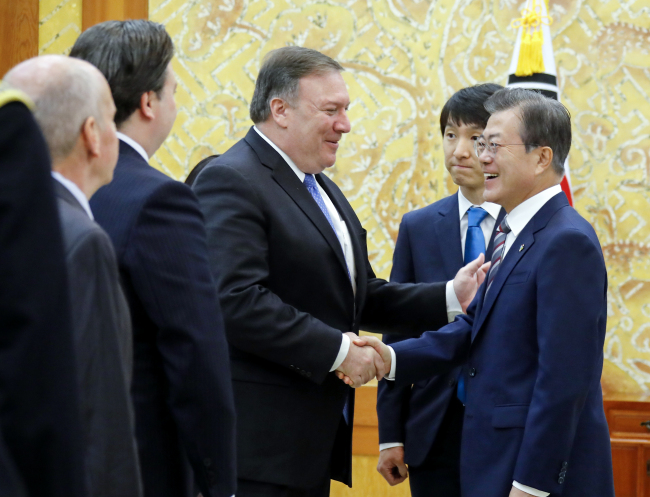President Moon Jae-in's "new economic road map" for the Korean Peninsula may get its needed momentum once North Korea's denuclearization gets on track, with details getting added to the unified market and economic cooperation belts that he envisioned, according to watchers here Thursday.
Prospects of improved and even new economic tieups with the North brightened after the historic North Korea-US summit in Singapore on Tuesday. The premise is that the international sanctions imposed on the North would fade out as Pyongyang moves toward getting rid of its nuclear weapons and other weapons of mass destruction programs.
Moon has already given the North's top leader Kim Jong-un his vision of what the tieups would look like. Kim was given a USB drive during their summit on April 27, whose contents have not be publicly shared, not even with senior government officials.
 |
South Korean President Moon Jae-in, right, shakes hands with US Secretary of State Mike Pompeo at the Blue House in Seoul on Thursday. (Yonhap) |
What is known is that the road map looks ahead to balanced development between the two Koreas and an economic unification that would create a new growth momentum, which would lead to the exploration of a northward economy.
"A unified market means South and North Korea activating economic cooperation using the market's role and functions and eventually uniting their markets," Im Kang-taek, a senior researcher at the Korea Institute for National Unification, said in a recent report. For such market integration, there would have to be open paths between the two Koreas in travel, communication and customs, means for labor management, and marketplaces at border regions, as well as in Seoul and Pyongyang to sell the products from the two sides, he said.
The economic cooperation belts would be three-pronged, divided into the eastern and western coasts and the border area, to build physical networks. The eastern coast belt would be for energy and resources and incorporate the "northern triangle" linking South Korea's southeastern port city of Busan, the two Koreas, China and Russia, and the "southern triangle" that runs through Busan, the North's Rajin-Sonbong free economic zones and Japan's Niigata Port.
The western coast belt will serve as the industry, logistics and transportation network that links South Korea's western cities with North Korea's border city of Kaesong to interconnect with Pyongyang and China's Shanghai. A high-speed transportation system would connect Seoul and Beijing.
The border belt would be for the environment and tourism. South and North Korea would operate ecotours and green business, and engage in joint water resources projects.
"South Korea is the 11th-largest economy globally. If the new economic road map becomes actualized and produces an economic effect, becoming the seventh largest would be within reach," Lee Jae-young, president of the Korea Institute for International Economic Policy, said in an interview with Yonhap on May 8. "We can be even more ambitious." (Yonhap)






![[Exclusive] Hyundai Mobis eyes closer ties with BYD](http://res.heraldm.com/phpwas/restmb_idxmake.php?idx=644&simg=/content/image/2024/11/25/20241125050044_0.jpg)
![[Herald Review] 'Gangnam B-Side' combines social realism with masterful suspense, performance](http://res.heraldm.com/phpwas/restmb_idxmake.php?idx=644&simg=/content/image/2024/11/25/20241125050072_0.jpg)
